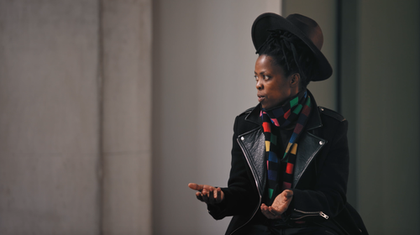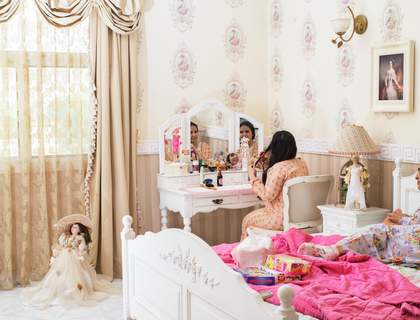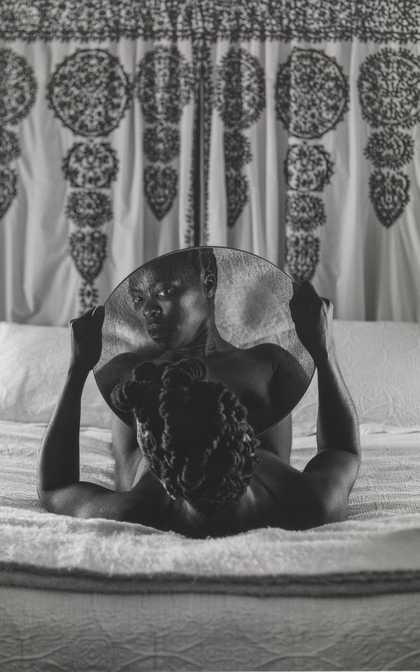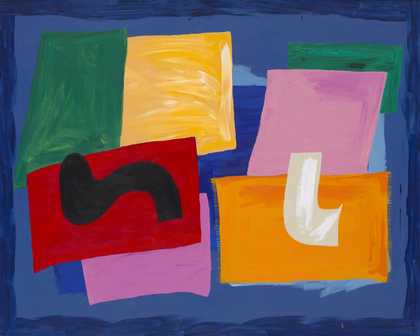

Zanele Muholi
Hear how the power of images can show LGBTQIA+ people that they are not alone through Muholi’s approach to portraiture and visual activism
Content Guidance
This video discusses racism, violence, and sexual violence, and contains images of nudity. We suggest teachers assess the suitability of this resource for their students
About the video
Encourage your students to respond to the video in their own ways – perhaps by making notes, doodles or drawings, or through gestures and sounds.
Visual activist Zanele Muholi uses photography and film to document and explore issues of race and representation and to celebrate the LGBTQIA+ community in South Africa and beyond.
"In my world, every human is beautiful"
Zanele Muholi
In this video they talk about how the power of images can show LGBTQIA+ people that they are not alone. Watch as they introduce us to four key bodies of work and the ideas behind them. Zanele Muholi is rewriting visual history and challenging the way we think about art. Their work is bold and confrontational but also tender, beautiful and loving. It includes self-portraits that explore themes of Blackness and selfhood, and intimate photographs of LGBTQIA+ people of colour.
Discuss
Your students' ideas and experiences are the best starting point for any discussion. Using the prompts below, support meaningful and creative discussions in the classroom about the video’s key themes. Discover how Zanele Muholi’s practice can inspire your students to learn with art.
Portraiture and Representation
Speaking about their work Muholi says, ‘what matters most is who is in the picture, and why’. While making their artwork they work in collaboration with the people in their pictures to maintain a human-to-human connection.
Prompts
- What do you think about Muholi’s statement that what matters most about their work is ‘who is in the picture’? Why do you think they’ve chosen to take photographs of specific people? What stories are they trying to share with us?
- How can a portrait can tell us something about the person in the image? What can we learn from their expression, clothes, objects and the background setting?
- Muholi suggests that portraits of individuals can tell us something about the community that they come from. Think about your family photographs; what might someone else be able to learn about your family's connections, interests, history or culture?
Visual Activism
Muholi describes themself as a visual activist. They use their camera as a way of capturing important issues and increasing awareness. They describe their work as ‘documenting realities of people who deserve to be heard, who deserve to be seen and whose lives are often excluded as part of the canon’.
Prompts
- Have you heard of visual activism before? What do you think this suggests about the importance of the role art and artists can have in raising awareness about different issues?
- What would you like to see changed in the world? Think about this from as many perspectives as possible. These prompt words might help: environment, community, health, discrimination, injustice, poverty, diversity.
- How could your art change how people think and feel about the issues you care about?
Beauty and Belonging
When Muholi says, ‘In my world, every human is beautiful’, it suggests that sometimes some people, places and things are considered to be not beautiful. Muholi has decided to state that everyone is beautiful and wants to share this message with the world.
Prompts
- What have you learned about beauty in art? Are there any rules you’d like to break?
- How would you capture the things you find beautiful? How would you share this with others?
- How could you use art to empower the people in your life and help them feel beautiful?
How to use Artist Stories
Introduce art and artists into your classroom with Artist Stories resources. The resources combine engaging videos and thoughtful discussion points to encourage confidence, self-expression and critical thinking. Art is a powerful tool for discussing the big ideas that impact young people's lives today.
- Explore the video:
- Read About the video to introduce the artists to your students.
- Project the video or watch it in smaller groups.
- Each video is between 3–10 minutes.
- Transcripts are included where available
2. Discuss the video:
- Invite your students to respond to a discussion prompt individually. They could record their responses through writing, drawing, making or voice recording. (5 minutes)
- Invite your students to share their ideas and responses with someone else. What have they learned about themselves or others by sharing their responses? (5 minutes)
- Invite your class to share their thoughts and ideas in groups or as a whole class, inviting multiple perspectives and experiences. (10 minutes)



